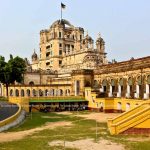Claude Martin ‘Celebrating Death’
Claude Martin had especially mentioned in his will that his death should not be commemorated as a day of mourning but as a festival or celebration.
La Martiniere College, Lucknow celebrates its Founder’s Day on September 13, the day Claude Martin died in 1800. His net worth then was over Rs.40 lakh.
But before we proceed to tell you what stuff Martin was made of, here’s a million-dollar teaser to all those currency converters and speculators out there: Guess how much Rs.4,000,000 or four million (to make it sound easy) in the year 1800 would be today.
Zapped? Don’t waste your brains! I tell you why? Because the rupee has had a solid pounding, later dollaring, over the decades that have gone by. And with fluctuations in real estate calculations, no calculation would stand the test of time. So back to Martin….

Claude Martin had especially mentioned in his will that his death should not be commemorated as a day of mourning but as a festival or celebration. On this special day, various activities are conducted in the college – formal assembly in the morning, singing of the school song and hymns by the college choir, performance by the bagpipers’ band and laying of a wreath at Claude Martin’s tomb.
Claude Martin was born on 5 January 1735 in Lyon, France. He was the son of Fleury Martin and Anne Vaginay. He was a Frenchman by birth and Briton by choice. After spending many years in North India fighting (for the British East India Company army, he arrived in Lucknow in 1776. His appointment was due to the East India Company’s increased military presence in Oudh. Those days, communications between the company and the Nawabs were conducted by military officers.
In 1778 war broke out in France and lasted till 1783. It affected Oudh too as the Company’s urgent need of money inflicted heavier demands on Nawabs. Martin was a brave, ambitious and a naturally talented Frenchman. He drew rent on more than a dozen properties in Lucknow, and ran his export business, ranging from sugar and shawls to attar, indigo and blue dye.
In Lucknow, he stayed in Farhat Baksh, a luxurious house that he designed. A unique feature of the house was that it automatically channelled water from the Gomti to cool the rooms. Martin was a passionate collector of Indian manuscripts, weapons, paintings and decorative objects.

Asaf-ud-daula had good reason to compete with Claude Martin. Both collected European objects to advertise their power, wealth and status.
During his last days, Martin designed Constantia. His great mausoleum, now the La Martiniere College, Lucknow, is perhaps the most glorious hybrid building in India. La Martiniere College established in 1840, one of the oldest school in India, is one such institution which has been a perfect example of such a nostalgia for many of its alumni. La Martiniere College is an institution of legendary propriety and distinction. The school produced generations of district magistrates, civil servants and Indian Army officers. The names of many Victorian pupils – Lyons, Raymond are still carved on the front steps of the school. Since then La Martiniere College has educated several members of the Nehru-Gandhi dynasty, as well as produced a great number of cabinet ministers, industrialists and newspaper editors.
I was told by one old boy that the 12 years of going to La Martiniere School was a treasure in itself; it gave freely of its riches, expecting nothing in return. Rajendra K. Pachauri, Vijay Mallya, Priyanka Chopra, Nafisa Ali, Leander Paes, Roshan Abbas and Muzaffar Ali studied at La Martinière. The alumni support La Martiniere College in many of its activities. This reinforces the bonding that former pupils of the college maintain with the generation of boys and girls that who are currently studying here. Old boys still love to go to the chapel on Founder’s Day and listen to a choir made up of Anglo-Indians, Muslims and Hindus sing: The Lord is my shepherd…..
Claude Martin used to live like a Muslim prince, but with taste and interest matching a renaissance man’s. Writing Persian couplets, experimenting with map-making, studying Botany, exploring hot-air balloons and even bladder surgery.

Martin’s will is written in French-English, which shows that he never acquired proficiency in English language. To all the four women, whom he treated as wives, left pensions and provision. But his charity extended far beyond his household and family. He left money for the relief of the poor in Lucknow, Calcutta and Lyon. More importantly, a major portion of his wealth went for promotion of literacy. It is strange to think of this foreigner, whose mother died when he was still a baby, who had never seen his father since, devoting his wealth to those who did not belong to him…children of a foreign race and religion.
The schools were established in Lucknow, Calcutta and Lyon. He most probably enjoyed his role as a ‘nabob’. Salute, to a great man!
Mohsina Mirza




